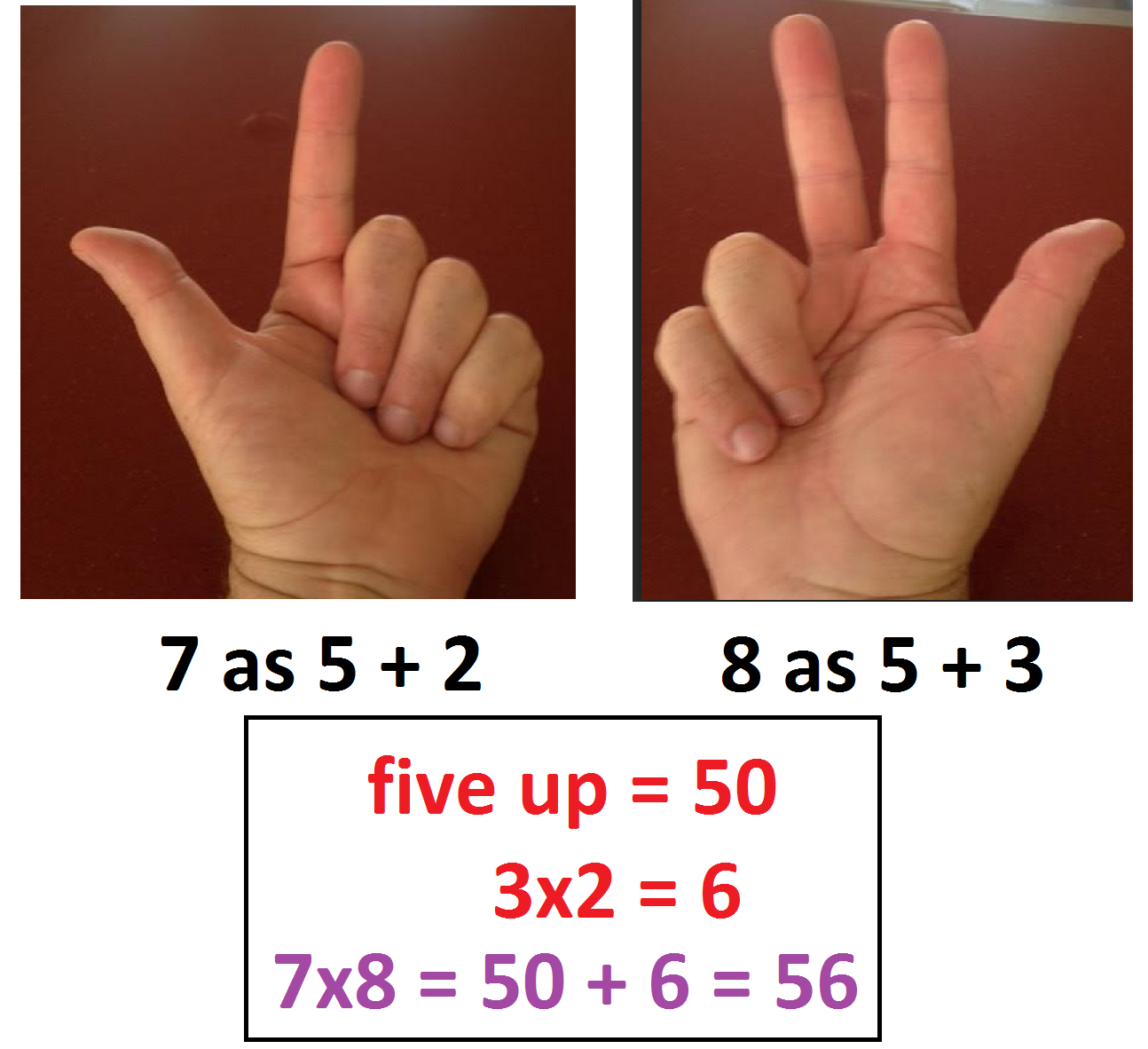The Astounding Power of Area
1.6 An aside on Finger Multiplication
[Here’s a video for this lovely piece: Finger Multiplication.]
Don’t memorize your multiplication tables. Let your fingers do the work! If you are comfortable with multiples of two, three, four, and five, then there is an easy way to compute values in the six- through ten-times tables.
First encode numbers this way:
A closed fist represents five and any finger raised on that hand adds one to that value.
Thus a hand with two fingers raised, for example, represents \(7\) and a hand with three fingers raised represents \(8\).
To multiply two numbers between five and ten do the following:
1. Encode the two numbers, one on each hand, and count \(10\) for each finger raised.
2. Count the number of unraised fingers on each hand and multiply together those two counts.
3. Add the results of steps one and two. This is the desired product.

For example, \(7\times8\) is represented as two raised fingers on the left hand, three on the right hand. There are five raised fingers in all, yielding the number \(50\) for step 1. The left hand has three lowered fingers and the right, two. We compute \(3\times2=6\). Thus the desired product is \(50+6=56\).
Similarly, nine times seven is computed as \(60+1\times 3 = 63\), and nine times nine as \(80 + 1\times1 = 81\). (Check these! Also compute \(6 \times 7\) and \(10 \times 10\).) Notice that one is never required to multiply two numbers greater than five!
EXERCISE: Explain why this trick works.
HINT: Suppose \(a\) fingers are raised on the left hand and \(b\) on the right. This means we are looking for the product \(\left(5+a\right)\left(5+b\right)\). Write the algebraic expression that results from performing steps 1, 2, 3. Show that the two algebraic expressions are the same.
FINGERS AND TOES: One can compute higher products using the same method with all twenty digits, fingers and toes. For example, interpret \(17\times18\) as, among the fingers, seven raised fingers for \(17\) and, among the toes, eight raised toes for \(18\). This time count each raised digit as worth \(20\) (we have twenty digits after all) and multiply the count of down digits. This yields \(17\times18 = 15\times 20 + 3\times 2= 306\) .
EXERCISE: Explain why this works.
EXERCISE: Martians have two hands with six fingers per hand. What is the Martian version of the finger multiplication trick?
Venusians have two hands, but with seven fingers on one hand and four on the other. What is their version of the finger multiplication trick?
Is there a version of the finger multiplication trick for Plutonians who have three hands with ten fingers on each hand?
Resources
Books
Take your understanding to the next level with easy to understand books by James Tanton.
BROWSE BOOKS![]()
Guides & Solutions
Dive deeper into key topics through detailed, easy to follow guides and solution sets.
BROWSE GUIDES![]()
Donations
Consider supporting G'Day Math! with a donation, of any amount.
Your support is so much appreciated and enables the continued creation of great course content. Thanks!
Ready to Help?
Donations can be made via PayPal and major credit cards. A PayPal account is not required. Many thanks!
DONATE![]()


